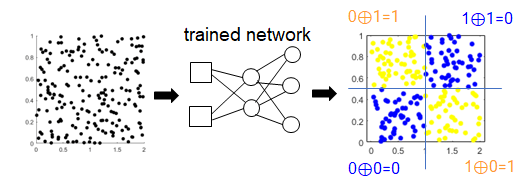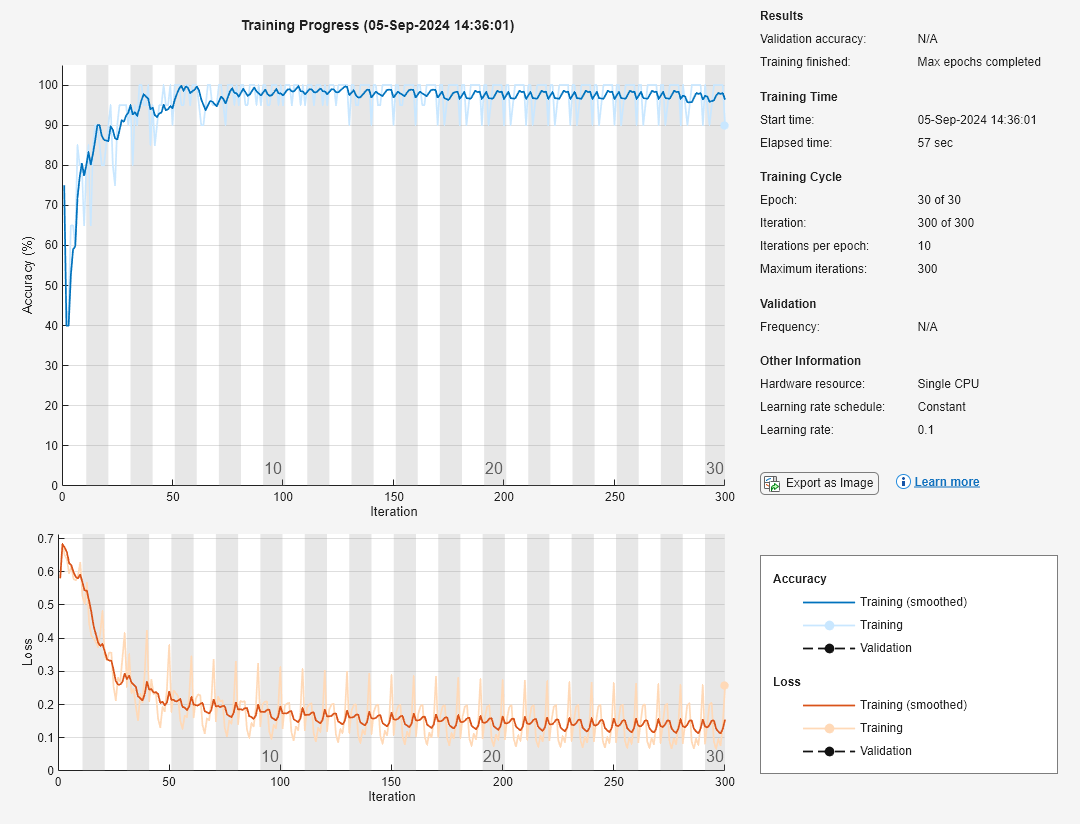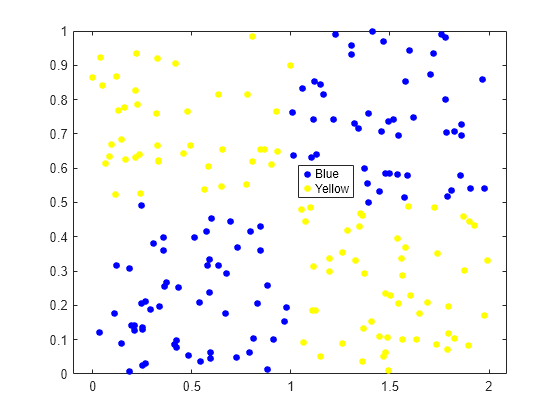Solve XOR Problem Using Quantum Neural Network (QNN)
This example shows how to solve the XOR problem using a trained quantum neural network (QNN). You use the network to classify the classical data of 2-D coordinates. A QNN is a machine learning model that combines quantum computing layers and classical layers. This example shows how to train such a hybrid network for a classification problem that is nonlinearly separable, such as the exclusive-OR (XOR) problem.

In the XOR problem, two-dimensional (2-D) data points are classified based on the region of their x- and y-coordinates using a mapping function that resembles the XOR function. If the x- and y-coordinates are both in region 0 or 1, then the data are classified into class "0". Otherwise, the data are classified into class "1". In this problem, a single linear decision boundary cannot solve the classification problem. Instead, nonlinear decision boundaries are required to classify the data.
This example shows a proof-of-concept idea about how to train a QNN using a local simulation. For more general frameworks using a hybrid quantum-classical model to classify quantum and classical data, see references [1] and [2]. The QNN in this example consists of four layers:
A feature input layer for the XOR problem.
A parameterized quantum circuit (PQC) as the ansatz circuit. This circuit prepares the states of qubits according to the coordinates of the input data with learnable parameters. The circuit then measures the probability distributions of the quantum states along the z-axis and passes them to the next layers.
A fully connected layer that applies a linear transformation to the quantum circuit measurements through a weight matrix and a bias vector.
A two-output softmax layer, which outputs probabilities for the data classification.

Finally, train the network by computing the cross-entropy loss for classification and propagating the gradients of the loss with respect to the learnable parameters through the layers, using the stochastic gradient descent with momentum (SGDM) optimizer.
Generate Training and Validation Data
The generateData function creates a sample of data points for the XOR problem. This function classifies data into two groups: "Blue" and "Yellow". If the coordinates of the data points satisfy and , or and , then this function classifies the data points as "Blue". Otherwise, if the coordinates of the data points satisfy and , or and , then this function classifies the data points as "Yellow".
function [X,Y] = generateData(numSamples) X = zeros(numSamples,2); labels = strings(numSamples,1); for i = 1:numSamples x1 = 2*rand; x2 = rand; X(i,:) = [x1 x2]; if (x1 > 1 && x2 > 0.5) || (x1 < 1 && x2 < 0.5) labels(i) = "Blue"; else labels(i) = "Yellow"; end end Y = categorical(labels); end
Generate training data with 200 data points using the generateData function. The network classifies the data into the "Blue" and "Yellow" classes.
numSamples = 200; [X,Y] = generateData(numSamples); classNames = ["Blue", "Yellow"];
The input for each data point has the form of 2-D coordinates. Specify the number of classes in the training data.
inputSize = size(X,2); numClasses = numel(classNames);
Next, generate validation data with 100 data points using the generateData function.
numValidation = 100; [XValidation,YValidation] = generateData(numValidation);
Create Parameterized Quantum Computing layer
Define a custom layer for the quantum circuit. For more information about creating a custom deep learning layer in MATLAB®, see Define Custom Deep Learning Layer with Learnable Parameters (Deep Learning Toolbox).
Forward Pass
The quantum circuit consists of two qubits that are initially in the state. Construct the quantum circuit by applying an RX gate with the rotation angle to the first qubit and an RX gate with the rotation angle to the second qubit, followed by a controlled NOT gate to the first qubit as the control and the second qubit as the target. These gates prepare the states of the qubits according to the coordinates of the input data by introducing two adjustable learnable parameters A and B in the rotation angles. These parameters are the scaling factors for the rotation angles of each qubit, which scale the x- and y-coordinates of the XOR problem to and . You then perform a measurement on the second qubit in the Z basis. The quantity of interest is the magnetization of the second qubit, which is the difference in counts of this qubit being in the state and the state. For this quantum circuit, the measured quantity has a predicted form of based on the states of the qubits. You then use the condition to determine the classification boundaries of the XOR problem. In this conceptual example, you use local simulation to determine the probabilities of measuring the qubit in these states instead of real counts on quantum hardware.

Backpropagation
To train the network, the derivative of the loss function through the quantum computing layer needs to be backpropagated. Backpropagation requires the computation of the gradients of with respect to the learnable parameters. To find these gradients, use the parameter-shift rules that are valid at the operator level, as described in [3] and [4]. For this quantum circuit, these equations give the gradients of with respect to the learnable parameters A and B.
As in [3], the gradients of the expectation values are exact for any choice of s as long as s is not an integer multiple of . This example chooses .
Define Custom Layer
To create a custom layer for the quantum circuit, create the PQCLayer class with this definition:
In the
propertiesblock, define the learnable parametersAandB.Specify the layer constructor function as
PQCLayer. In the constructor, specify the layer name, the layer description, and the initial values of the learnable parameters.Specify the
predictlayer, which computes the measurement at prediction time.Specify the
backwardlayer, which backpropagates the derivative of the loss function through the layer. You do not need the gradients of with respect to the x- and y-coordinates because you do not use the gradients of the loss function with respect to x and y during training.Specify a
computeZfunction that defines the quantum circuit and computes the measurement. Create the quantum circuit with two qubits by usingquantumCircuit. Add the two RX gates with the rotation angles and by usingrxGateand the CNOT gate by usingcxGate. Locally simulate the final state of the quantum circuit by usingsimulate. Compute the predicted measurement on the second qubit by using theprobabilityfunction to find the difference in counts of this qubit being in the state and the state.
Save the PQCLayer class definition in a separate file on the path.
classdef PQCLayer < nnet.layer.Layer % Custom PQC layer example. properties (Learnable) % Define layer learnable parameters. A B end methods function layer = PQCLayer % Set layer name. layer.Name = "PQC"; % Set layer description. layer.Description = "Layer containing a parameterized " + ... "quantum circuit (PQC)"; % Initialize learnable parameter. layer.A = 1; layer.B = 2; end function Z = predict(layer,X) % Z = predict(layer,X) forwards the input data X through the % layer and outputs the result Z at prediction time. Z = computeZ(X,layer.A,layer.B); end function [dLdX,dLdA,dLdB] = backward(layer,X,Z,dLdZ,memory) % Backpropagate the derivative of the loss % function through the layer. % % Inputs: % layer - Layer though which data backpropagates % X - Layer input data % Z - Layer output data % dLdZ - Derivative of loss with respect to layer % output % memory - Memory value from forward function % Outputs: % dLdX - Derivative of loss with respect to layer input % dLdA - Derivative of loss with respect to learnable % parameter A % dLdB - Derivative of loss with respect to learnable % parameter B s = pi/4; ZPlus = computeZ(X,layer.A + s,layer.B); ZMinus = computeZ(X,layer.A - s,layer.B); dZdA = X(1,:).*((ZPlus - ZMinus)./(2*sin(X(1,:).*s))); dLdA = sum(dLdZ.*dZdA,"all"); ZPlus = computeZ(X,layer.A,layer.B + s); ZMinus = computeZ(X,layer.A,layer.B - s); dZdB = X(2,:).*(((ZPlus - ZMinus)./(2*sin(X(2,:).*s)))); dLdB = sum(dLdZ.*dZdB,"all"); % Set the gradients with respect to x and y to zero % because the QNN does not use them during training. dLdX = zeros(size(X),"like",X); end end end function Z = computeZ(X, A, B) numSamples = size(X,2); x1 = X(1,:); x2 = X(2,:); Z = zeros(1,numSamples,"like",X); for i = 1:numSamples circ = quantumCircuit(2); circ.Gates = [rxGate(1,x1(i)*A); rxGate(2,x2(i)*B); cxGate(1,2)]; s = simulate(circ); Z(i) = probability(s,2,"0") - probability(s,2,"1"); end end
Define Network Architecture
Define the layers in the QNN that you train to solve the XOR problem.
Create a feature input layer with observations consisting of two features. These features correspond to the coordinates of the XOR problem.
Specify a quantum computing layer using the
PQCLayerclass.For classification, specify a fully connected layer with a size equal to the number of classes.
Map the output to probabilities by including a softmax layer.
layers = [featureInputLayer(inputSize)
PQCLayer
fullyConnectedLayer(numClasses)
softmaxLayer];Specify Training Options
Configure the SGDM optimizer with a mini-batch size of 20 for each iteration, a learning rate of 0.1, and a momentum of 0.9. Specify data for validation during training, with a validation frequency of 10 iterations. Shuffle the training data before each training epoch and shuffle the validation data before each neural network validation. Use the CPU to train the network. Turn on the training progress plot to monitor accuracy and suppress the training progress indicator in the Command Window.
options = trainingOptions("sgdm", ... MiniBatchSize=20, ... InitialLearnRate=0.1, ... Momentum=0.9, ... ValidationData={XValidation,YValidation}, ... ValidationFrequency=5, ... Shuffle="every-epoch", ... ExecutionEnvironment="cpu", ... Plots="training-progress", ... Metrics="accuracy", ... Verbose=false);
Train Network
Train the QNN. For classification, use cross-entropy loss. After 300 iterations, the result shows an excellent accuracy above 90% for classifying the XOR problem.
net = trainnet(X,Y,layers,"crossentropy",options)
net =
dlnetwork with properties:
Layers: [4×1 nnet.cnn.layer.Layer]
Connections: [3×2 table]
Learnables: [4×3 table]
State: [0×3 table]
InputNames: {'input'}
OutputNames: {'softmax'}
Initialized: 1
View summary with summary.
Test Network
Test the classification accuracy of the network by comparing the predictions on the test data with the true labels.
Generate new test data not used during training.
[XTest,trueLabels] = generateData(numSamples);
Compute the output of the trained network for inference given the test data. Convert this output into predicted class labels.
YTest = predict(net,XTest); predictedLabels = scores2label(YTest,classNames);
Plot the predicted classification for the test data.
gscatter(XTest(:,1),XTest(:,2),predictedLabels,"by")
Visualize the accuracy of the predictions in a confusion chart. Large values on the diagonal indicate accurate predictions for the corresponding class. Large values on the off-diagonal indicate strong confusion between the corresponding classes. Here, the confusion chart shows very small errors in classifying the test data.
confusionchart(trueLabels,predictedLabels)

Finally, calculate the classification accuracy of the trained network given the test data.
accuracy = testnet(net,XTest,trueLabels,"accuracy")accuracy = 99
References
[1] Broughton, Michael, Guillaume Verdon, Trevor McCourt, Antonio J. Martinez, Jae Hyeon Yoo, Sergei V. Isakov, Philip Massey, et al. "TensorFlow Quantum: A Software Framework for Quantum Machine Learning." Preprint, submitted August 26, 2021. https://doi.org/10.48550/arXiv.2003.02989.
[2] Farhi, Edward, and Hartmut Neven. "Classification with Quantum Neural Networks on Near Term Processors." Preprint, submitted August 30, 2018. https://doi.org/10.48550/arXiv.1802.06002.
[3] Mari, Andrea, Thomas R. Bromley, and Nathan Killoran. “Estimating the Gradient and Higher-Order Derivatives on Quantum Hardware.” Physical Review A 103, no. 1 (January 11, 2021): 012405. https://doi.org/10.1103/PhysRevA.103.012405.
[4] Wierichs, David, Josh Izaac, Cody Wang, and Cedric Yen-Yu Lin. “General Parameter-Shift Rules for Quantum Gradients.” Quantum 6 (March 30, 2022): 677. https://doi.org/10.22331/q-2022-03-30-677.